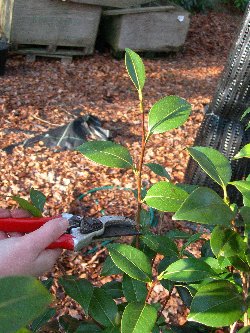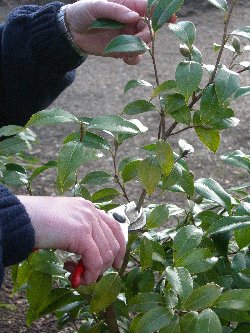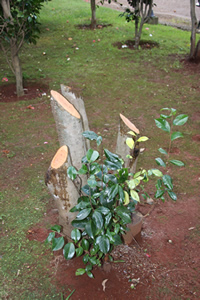|
Left to their own devices, and given sufficient time, most Camellias will eventually form a large shrub or small tree. While this may be fine in a woodland setting where space is not an issue and a natural look is desirable, Camellias grown in small gardens or containers will benefit from regular pruning, both to restrict the plants size and to maintain a pleasing shape. Sometimes gardeners can be anxious about doing this, but Camellias respond very well to being pruned as this actually encourages new growth and, unlike some plants, they readily produce new shoots from old wood.
 Pruning should ideally be carried out in spring just before the first flush of growth begins - in most cases this will be just as flowering has finished - and should always be done using sharp secateurs.
Young plants should require no more than a light cutting back of the previous years growth, which will encourage the side shoots to grow and make a bushier plant. Look for the newest wood that grew the previous year and reduce this in length by about a third to a half, always cutting back to just above a leaf - the new shoots will grow from the axil between the leaf and stem.
If the shape of the plant looks unbalanced then the pruning can be harder, cutting back into older wood or removing an entire branch if necessary, cutting back to the main stem. In late spring or early summer, once the plant has finished its first growth spurt, it is possible to pinch out the tips of any long, newly grown shoots to prevent the plant becoming straggly and to encourage further branching. It pays to establish a good shape initially while the plant is young, and then to maintain it as it grows.

As the plant gets older, continue with light, annual pruning and if necessary this can be used to control the shape - e.g. remove more growth from the top to restrict height and encourage the plant to spread, or prune only side branches if you want the plant to grow taller more quickly.
Prune after flowering has finished, or for even better shape results, you can wait until all the new growth has stopped, although this will result in fewer flowers. Once it has grown as large as desirable, prune each year to prevent the plant outgrowing its allocated space.
Depending on the variety the growth may become very dense - thin out by removing some branches to allow more air to circulate and light to penetrate into the plant.

Occasionally where a mature plant has got completely out of hand, more drastic surgery can be required. If necessary, whole branches can be removed with loppers or a saw, or several feet can be removed from the top.
In the most drastic case a plant can be completely renovated by cutting it down entirely to leave just a foot or two of stump which will respond by producing a mass of vigorous young shoots.
When a Camellia has been pruned hard the number of flowers will be reduced in the following year or two as it responds primarily with vegetative growth, but in the longer term a more healthy and floriferous plant will result.
Pruning is an ideal method of creating a camellia hedge.
By diligent pruning from a young age, taking out the tips ('stopping' the new growth) of vertical branches, you can cause your camellia to branch out and form a lovely flowering hedge. Try planting different varieties at 3ft apart to create a mixed colour / mixed flowering season hedge.
Whilst tight clipping is possible to create a neat hedge, far more fashionable at the moment is to take a very relaxed pruning regime, allowing a naturally shaped hedge to form, simply through the natural shape of the plant.
|


